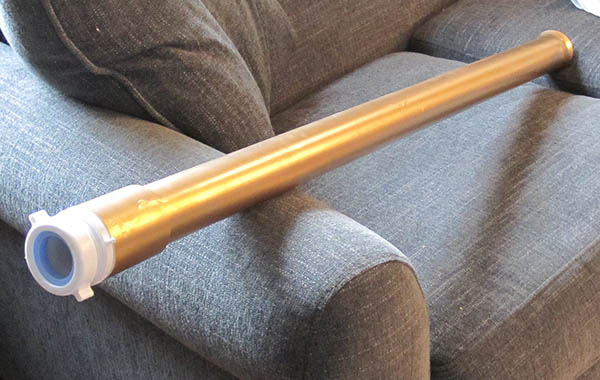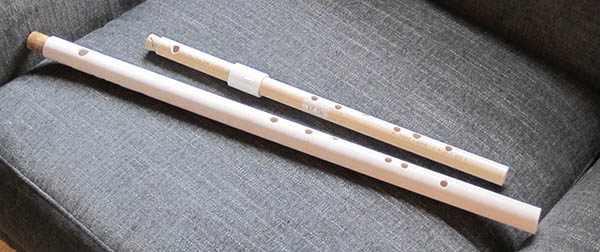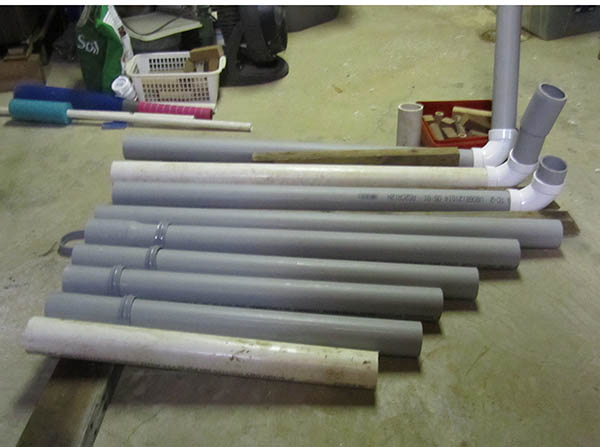
Click an image to view its enlargement
This is perhaps the simplest possible musical instrument. It’s a random length of 1½ inch pipe. You put your lips loosely together and blow into one end, and you get a low droning tone.
The pipe alone was uncomfortable on my lips, so I added a sink-trap adaptor to narrow the opening a bit. (The traditional Australian didgeridoo uses beeswax, but I didn’t have any lying around.) For decoration, I flared the far end of the pipe by heating it with a hair dryer and pushing it onto a beer bottle that I had just emptied. A coat of paint was the final touch.

Click an image to view its enlargement
Next on the complexity scale is the 6-hole flute, sometimes called the Irish flute. The fingering is a lot like a recorder — you make sharps and flats by half-covering holes — but the embouchure gives you more control over how screechy the second octave sounds.

Tuning a flute is complicated by the fact that the pitch you get from a hole is affected by the position and size of lower holes. So the procedure is to start from the bottom, drilling the lowest hole a bit smaller and a bit lower on the pipe than calculations would suggest. You blow the note, measure the frequency, and then enlarge the hole to raise the pitch a bit. Repeat until it’s close enough. Then move up to the next hole.
For a solo instrument, you can tune the pipe by ear. But if you want to play in tune with another musical instrument, you should tune to standard frequencies. Fortunately, there are lots of free guitar-tuning apps for your computer or smart phone. I used NCH’s Pitch Perfect.
The larger flute, which is made of ¾-inch pipe, can go as low as D4 (293.67 Hz if you are tuning to A = 440). It gives a nice mellow tone, even in the second octave, but the holes are just a bit farther apart than my fingers would like. The ½-inch pipe goes down to G4 (392 Hz) and the closer hole spacing makes it much more comfortable to play.
This is a cross between a pipe organ and a timpani. You play it by slapping a shower shoe (beach flip-flop) over the ends of the pipes. The pipe emits a nice “boom” tone at a frequency determined by its length; longer pipes give a lower tone.
Optionally, you can paint your face blue and adopt a blank stare while playing it.
I started by making a spreadsheet to calculate the pipe lengths for standard pitches. In physics class, they teach the formula that relates wavelength, frequency and speed of sound. They also teach that a pipe open at both ends will resonate when it is half a wavelength long. But there are several real-world factors to take into account.
A visit to the local Home Depot revealed that there’s two kinds of Schedule 40 PVC pipe: white pipe for plumbing and gray pipe for electrical conduit. There may be important chemical differences between them. What I cared about was that electrical conduit is about 15% cheaper.
I cut pipes for a bit more than an octave of “white key” notes.

At that point, I realized how big this gadget was going to be when I added the “black key” pipes for sharps and flats. So it had to be an outdoor toy. And it needed a frame of some sort to hold the pipes at the right height for kids.
Assembling the rig outside, I realized two more things. First, rainwater would collect in the curved pipes and mosquitoes would breed. Solution: tip the rig over after every rain. Second, PVC pipe is heavy, and the frame would need more braces to survive being tipped over. Solution: add struts.

Test results on the finished project are mixed. Most of the pipes sound in tune with each other (for a tolerant ear — a serious musician might not agree). But the Pitch Perfect app shows that the pipes are not spot-on relative to the A=440 standard. I plan to do a detailed analysis at some point.
Finally, the acid test: Do small children want to play with it? Both Laurel and David were interested in making noises when I showed them the tubulum and gave a short demo. Whether they return to play with it in the future, only time will tell.

Photo taken in April 2016